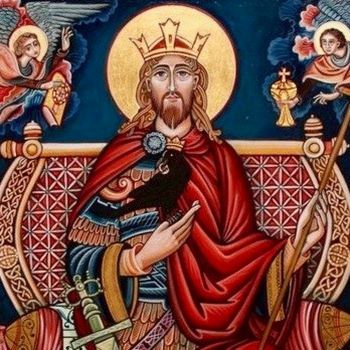St Oswald.

In 642 AD Oswald, the King of Northumbria who had previously converted to Christianity was killed by the pagan King Penda of Mercia in the Battle of Maserfield, only 400 metres from the site of the present church. His arm, having been severed from his body and picked up by a raven, was dropped "a bowshot" away, where a well is said to have sprung, visited for centuries for healing, and still there. The present-day name of Oswestry is a corruption of the original name Oswald’s Tree, which derives from Oswald's body being nailed to a tree in mock crucifixion.
The story of St Oswald can be read more fully HERE
Records show that Christian worship has taken place on the site of the present church for more than 1000 years with the earliest place of worship (possibly a monastery) on the same site before the large church was dedicated to St Oswald more than 900 years ago. When surveyed by John Leyland in about 1530 he makes reference to “this chirche was sumtime a monasterie called the White Minster” …. and ….. “the cloister stoode in the memory of men where there are monuments to monks”, but little is now known of the monastic period.
There is mention of an un-named church in the Domesday Book in 1086. The first reference to the church being dedicated to St Oswald appears in a tithe document in Shrewsbury Abbey in the same year.
Throughout mediaeval history, Oswestry’s Welsh border location left it vulnerable to attack but none more so than during the 13th century. Some of these attacks took place in 1216, 1233 and 1282 – the resultant border changes taking Oswestry in and out of Wales on several occasions. Despite there being no documentary evidence that St Oswald’s was attacked, there is clear evidence of some 13th century construction work.
In 1599 William Morgan, well known for translating the whole Bible into Welsh, was appointed Vicar of Oswestry.
The body of the church was extensively damaged during the Civil War, when it was used as stables by the Parliamentarians, but the rebuild of the church was finally completed in the early 1670s.
An interesting feature of the interior of the church is the Yale memorial dated 1616 (restored in 1676) to the memory of the Alderman Hugh Yale, part of whose family endowed Yale University in the United States.
During 1872-1874, renowned Victorian architect G E Street undertook substantial changes to the interior of the church at a cost of £12,650, bequeathing an architectural gem to this generation, which remains a focus for a living community of faith.
 A sketch of 1804, before the restoration in 1872-4, entitled 'Oswestry Church from the Griddle Gate'
A sketch of 1804, before the restoration in 1872-4, entitled 'Oswestry Church from the Griddle Gate'
This is now the lych gate near the former Grammar School, now a cafe in the churchyard, which dates from the 17th century. The earlier gate may have had a cattle grid to stop animals wandering into the churchyard, hence the name 'Griddle'.